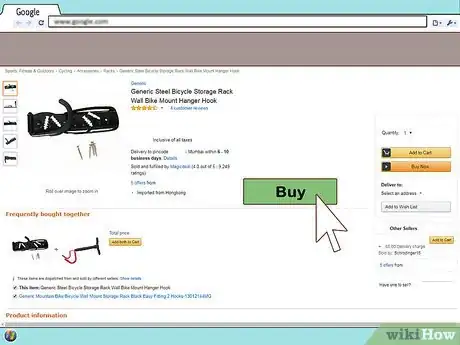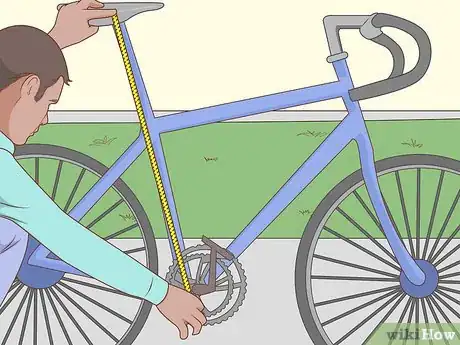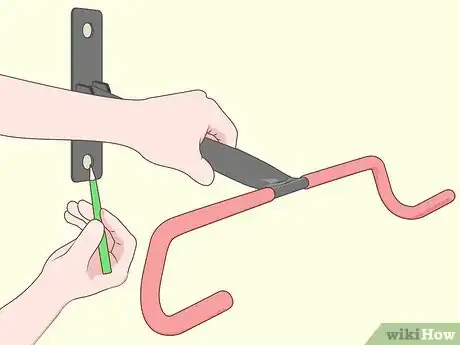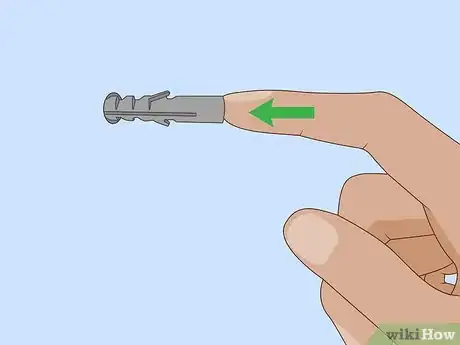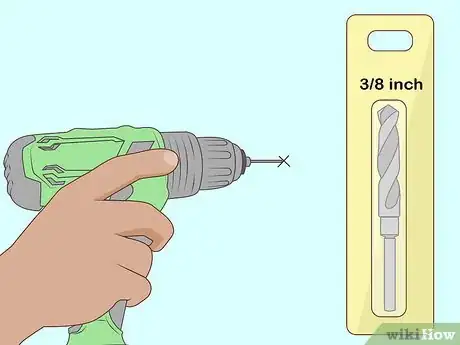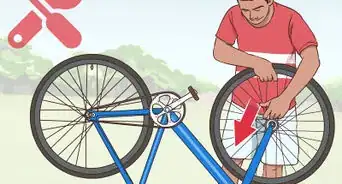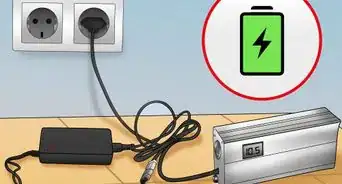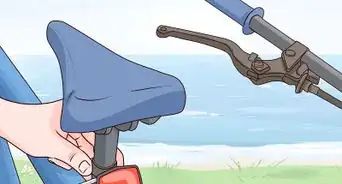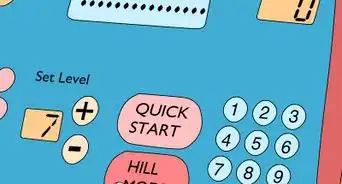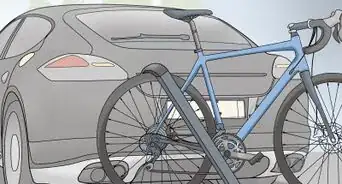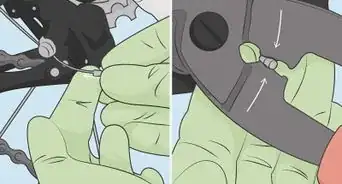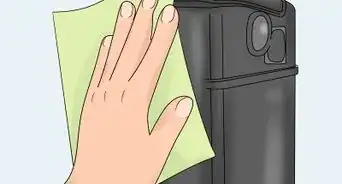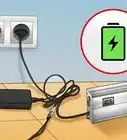This article was co-authored by Peter Salerno and by wikiHow staff writer, Kyle Hall. Peter Salerno is the owner of Hook it Up Installation, a professional installation company, which has been hanging art and other objects around Chicago, Illinois for over 10 years. Peter also has over 20 years of experience installing art and other mountable objects in residential, commercial, healthcare and hospitality contexts.
There are 8 references cited in this article, which can be found at the bottom of the page.
wikiHow marks an article as reader-approved once it receives enough positive feedback. In this case, 82% of readers who voted found the article helpful, earning it our reader-approved status.
This article has been viewed 646,908 times.
Storing your bike on the wall is a convenient way to save space and keep your bike safe from damage. To hang your bike on the wall securely, you’ll want to use a bike rack or a bike hook. After using a drill to properly install the mount for your bike, you'll have more free space and easy access to your bike whenever you're ready for a ride.
Steps
Installing a Bike Rack
-
1Get a wall-mount bike rack online or at your local hardware store. Choose a vertical or horizontal wall mount depending on how you want your bike to be stored. A vertical bike rack is a good option if you're trying to conserve wall space. Choose a horizontal bike rack if you want your bike to hang flat against the wall.[1] You can even build one if you want.
- You can find a wall-mount bike rack online here.
-
2Measure the bike with a tape measurer. Measure the length of the bike if you're using a vertical bike rack, or the height of the bike if you're using a horizontal bike rack.Advertisement
-
3Hold the bike rack on the wall where you want the bike to hang. Don't put the rack up too high or the bike might touch the ceiling when it's hung up. Once you have the rack in position, mark where all of the screw holes on the rack line up with the wall. Most bike racks have two screw holes.[2]
- If you’re using a horizontal rack, make sure the distance between the floor and the bike rack is greater than the height of the bike.
- If you’re using a vertical rack, make sure the distance between the floor and the bike rack is greater than the length of the bike.
-
4Use a drill to drill into the wall at the points you marked. Make sure the holes you drill are deep enough that the whole length of the screws will fit in them. Use a drill bit that is slightly smaller than the screws that came with the bike rack. [3]
- You can find power drills online here.
- For example, if the bike rack came with 6mm screws, use a 5mm drill bit.
-
5Push a wall plug into each hole you drilled. The wall plugs will give the screws you’re going to use to mount the bike rack something to grip onto. Use wall plugs that are the same size as the screws that came with the bike rack. You can find wall plugs at your local hardware store.[4]
-
6Line the rack up over the holes and screw it into place. Use a screwdriver to screw the screws that came with the bike rack into the wall plugs. Continue turning the screwdriver until the screws won't turn anymore. [5]
-
7Hang the bike on the bike rack. If you’re using a vertical bike rack, hang the bike by the front tire. If you’re using a horizontal bike rack, place the top tube of your bike frame on the rack.
Using a Bike Hook
-
1Get a bike hook that can hold the weight of the bike. The packaging on the hook should say the maximum load capacity. Don't use a hook that's not meant to hold the weight of the bike or it could pull out of the wall.
- You can find bike hooks at your local hardware store or online here.
- Use a bathroom scale to figure out the weight of the bike if you're unsure. Weigh just yourself on the scale, and then weigh yourself on the scale while holding the bike. Subtract your weight from the weight of you plus the bike - the number you're left with is how much your bike weighs.
EXPERT TIP"There are a lot of options for mounting your bike, but I prefer bike hooks. They're only a few dollars apiece, and they're simple to use."
Peter Salerno is the owner of Hook it Up Installation, a professional installation company, which has been hanging art and other objects around Chicago, Illinois for over 10 years. Peter also has over 20 years of experience installing art and other mountable objects in residential, commercial, healthcare and hospitality contexts.
Peter Salerno
Installation Expert Peter Salerno
Peter Salerno
Installation Expert -
2Use a stud finder to locate a stud in the wall. You can get a stud finder at your local hardware store. Place the stud finder on the wall and slowly move it across the wall until it indicates that a stud has been found. Usually stud finders light up or make a beeping sound when they’re over a stud. Read the instructions that came with your stud finder for specific directions on using it.
- You can find a stud finder online here.
-
3Use a tape measure to measure the length of the bike. Measure from the furthest tip of the front tire to the furthest tip of the back tire.
-
4Mark with a pencil where you want the bike hook to screw into the wall. Make sure it's somewhere along the stud you found. Because the bike will be hung vertically, make sure the distance between the floor and the bike hook is greater than the length of the bike.[6]
-
5Use a ⅜ inch (.95 cm) drill bit to drill a hole where you made the mark. Make sure the hole is deep enough that the entire screw end of the bike hook can fit into it.[7]
-
6Screw the bike hook into the hole you drilled until it’s secure. Insert the screw end of the bike hook into the hole and continue turning the hook clockwise until it won’t turn anymore. You want the hook itself to be parallel with the floor.[8]
-
7Hang the bike on the bike hook. Place the front tire of the bike on the hook so that the tires are touching the wall and the seat of the bike is facing outward, away from the wall.
Community Q&A
-
QuestionWhy don't bike hanging websites feature ladies bikes as well as men's bikes?
 Community AnswerAnymore, 'men's' bikes are considered the standard and 'women's' bikes are considered a frame option. Many women buy men's bikes because there are so many more options to chose from. So, they're just more common right now.
Community AnswerAnymore, 'men's' bikes are considered the standard and 'women's' bikes are considered a frame option. Many women buy men's bikes because there are so many more options to chose from. So, they're just more common right now. -
QuestionI have a set of bike storage shelves from CB2. There is no problem with a road bike, but the handlebars on a hybrid are wide and I have to turn the front wheel. Is it okay with the front wheel turned? Will it cause damage?
 Community AnswerThere will be no damage to the bike with a wheel turned. Think about all the shock and abuse a bike takes during a quickly-paced ride on rough ground. The only thing to worry about is the rim brakes (if applicable). There needs to be some coating or rubber between the wheel and the hook. Other than that you are golden.
Community AnswerThere will be no damage to the bike with a wheel turned. Think about all the shock and abuse a bike takes during a quickly-paced ride on rough ground. The only thing to worry about is the rim brakes (if applicable). There needs to be some coating or rubber between the wheel and the hook. Other than that you are golden. -
QuestionWhy does it matter if the back wheel of the bike rests on the floor when hanging from the wall?
 Community AnswerIf the back wheel rests on the ground, the bike will not be completely stable. This makes it easy to knock the bike off the hook.
Community AnswerIf the back wheel rests on the ground, the bike will not be completely stable. This makes it easy to knock the bike off the hook.
Things You’ll Need
- Bike rack
- Bike hooks
- Pencil
- Drill
- Wall plugs
- Stud finder
- Screwdriver
- Screws
- Tape measure
References
- ↑ https://www.bunnings.com.au/diy-advice/outdoor/garage/how-to-hang-a-bicycle
- ↑ https://www.youtube.com/watch?v=-5K9SyS81L4&feature=youtu.be&t=36
- ↑ https://www.youtube.com/watch?v=-5K9SyS81L4&feature=youtu.be&t=67
- ↑ https://www.youtube.com/watch?v=-5K9SyS81L4&feature=youtu.be&t=74
- ↑ https://snapguide.com/guides/wall-mount-your-bike/
- ↑ https://www.youtube.com/watch?v=D9NGzNWb_rQ&feature=youtu.be&t=64
- ↑ https://www.youtube.com/watch?v=D9NGzNWb_rQ&feature=youtu.be&t=95
- ↑ https://www.youtube.com/watch?v=D9NGzNWb_rQ&feature=youtu.be&t=96
About This Article
To hang a bike on the wall, start by buying a wall-mount bike rack either online or at a hardware store. Next, hold the bike rack flat against the wall where you’d like it to hang and mark the location of the screw holes with a pencil. Then, use a drill to make holes into the pencil marks and insert wall plugs or anchors into the holes. Once you’ve inserted the anchors, line the rack up over the holes and screw it into places with a screw driver. For tips on how to install a bike hook to hang your bike, read on!
